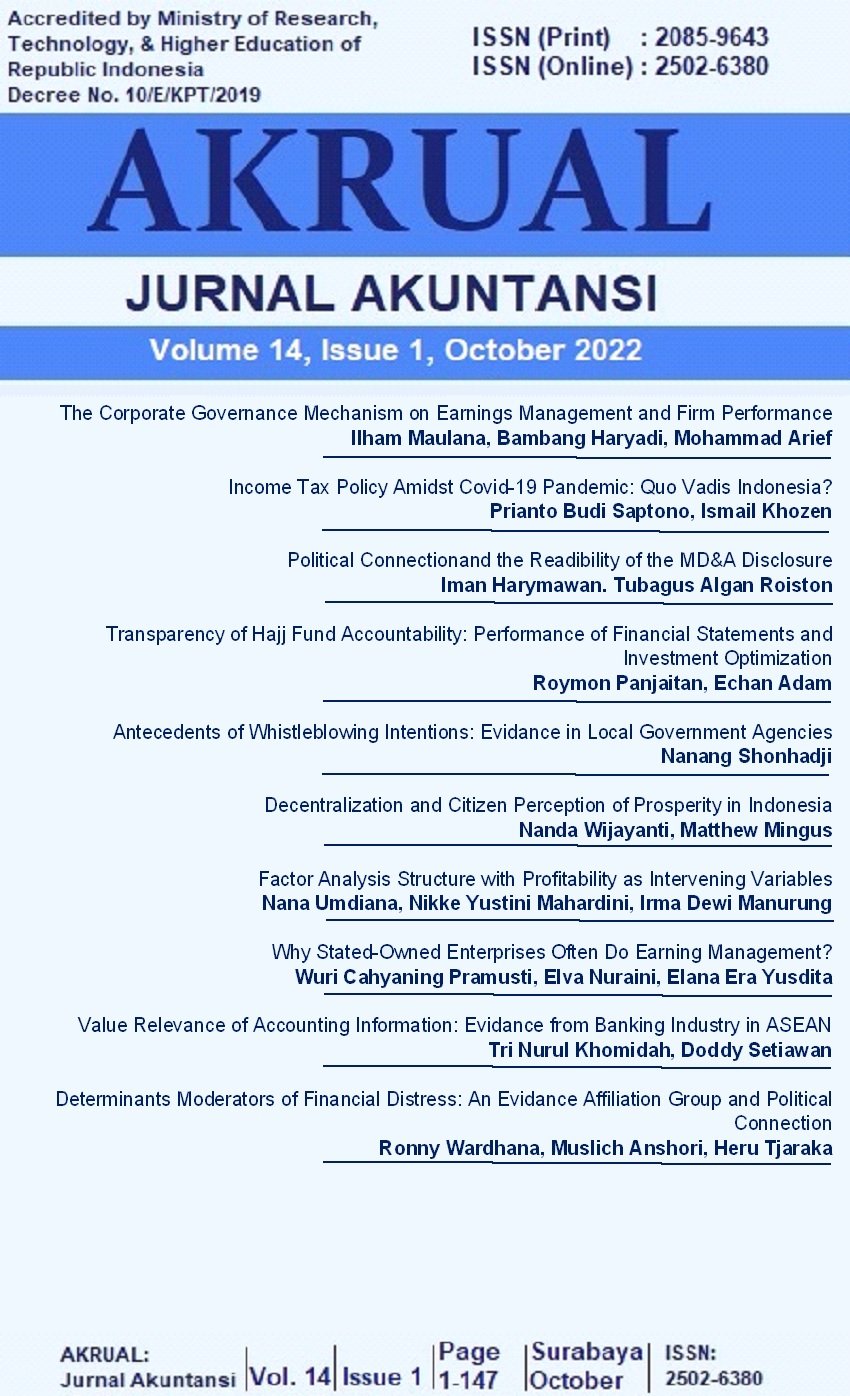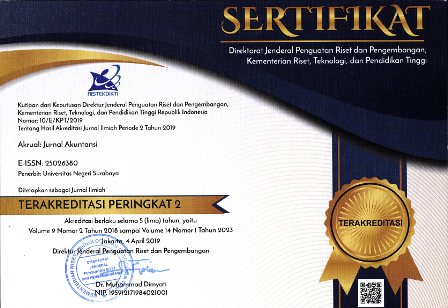Political Connection and the Readability of the MD&A Disclosure
DOI:
https://doi.org/10.26740/jaj.v14n1.p30-46Keywords:
Disclosure, MD&A, Political Connection, ReadabilityAbstract
This research examined the relationship between politically connected companies and the readability of the company's MD&A. Our results show that in the Indonesian setting, the experience of parliamentarians (DPR, MPR), regional heads and local government officials at the company executive level plays an important role in the readability of a company's Management Discussion & Analysis (MD&A). Based on self-presentation theory, we suspect that companies with political connections make it possible to make the disclosures on the company's MD&A easy to read because the management with political connections puts forward their image in the stakeholders' eyes. The narrative that is conveyed is easier to understand as a result. Besides this, management who come from the political circle have the talent and expertise of managing their image in the public eye, thus enabling the management to convey the narrative on MD&A in a way that is easy to read for reasons of concealing the company performance or maintaining their image. We also tested the endogeneity effect using Coarsened Exact Matching Regression (CEM) to confirm our findings and obtained the same result as our previous assumption - that politically connected companies have an MD&A that is easy to read.
References
Acemoglu, D., Johnson, S., Kermani, A., Kwak, J., & Mitton, T. (2016). The value of connections in turbulent times: Evidence from the United States. Journal of Financial Economics, 121(2), 368-391.
Ajina, A., Laouiti, M., &Msolli, B. (2016). Guiding through the Fog: Does annual report readability reveal earnings management?. Research in International Business and Finance, 38, 509-516.
Aidulsyah, F., Margiansyah, D., Kurniawan, F.E., Kusumaningrum, D., Sabilla, K., & Aini, Y.N. (2020).Map of Businessmen in Parliament: A Portrait of Oligarchy in Indonesia. Marepus Corner Working Paper No. 01. (in Bahasa)
Bank Indonesia. (2010). Implementation of the Anti-Money Laundering and Prevention of Terrorism Funding Programs for Rural Banks and Sharia Rural Banks (in Bahasa)
Baumeister, R. F. (1982). A self-presentational view of social phenomena. Psychological bulletin, 91(1), 3.
Berkman, H., Cole, R. A., & Fu, L. J. (2010). Political connections and minority-shareholder protection: Evidence from securities-market regulation in China. Journal of Financial and Quantitative Analysis, 1391-1417.
Bochkay, K., & Levine, C. B. (2019). Using MD&A to improve earnings forecasts. Journal of Accounting, Auditing & Finance, 34(3), 458-482.
Bunkanwanicha, P., &Wiwattanakantang, Y. (2009). Big business owners in politics. The Review of Financial Studies, 22(6), 2133-2168.
Carney, R. W., Child, T. B., & Li, X. (2020). Board connections and crisis performance: Family, state, and political networks. Journal of Corporate Finance, 101630.
Chen, C. J., Li, Z., Su, X., & Sun, Z. (2011). Rent-seeking incentives, corporate political connections, and the control structure of private firms: Chinese evidence. Journal of Corporate Finance, 17(2), 229-243.
Cingano, F., &Pinotti, P. (2013). Politicians at work: The private returns and social costs of political connections. Journal of the European Economic Association, 11(2), 433-465.
Clarke, G. (2006). Faith matters: faith?based organisations, civil society and international development. Journal of International Development: The Journal of the Development Studies Association, 18(6), 835-848.
Clarkson, P. M., Kao, J. L., & Richardson, G. D. (1994). The voluntary inclusion of forecasts in the MD&A section of annual reports. Contemporary accounting research, 11(1), 423-450.
Cole, C. J., & Jones, C. L. (2005). Management discussion and analysis: A review and implications for future research. Journal of Accounting Literature, 24, 135.
Cole, C. J., & Jones, C. L. (2015). The quality of management forecasts of capital expenditures and store openings in MD&A. Journal of Accounting, Auditing & Finance, 30(2), 127-149.
Duchin, R., &Sosyura, D. (2012). The politics of government investment. Journal of Financial Economics, 106(1), 24-48.
Durnev, Art, and Claudine Mangen. "The spillover effects of MD&A disclosures for real investment: The role of industry competition." Journal of Accounting and Economics (2020): 101299.
Dutta, S., Fuksa, M., & Macaulay, K. (2019). Determinants of MD&A sentiment in Canada. International Review of Economics & Finance, 60(C), 130-148.
Dyer, T., Lang, M., &Stice-Lawrence, L. (2017). The evolution of 10-K textual disclosure: Evidence from Latent Dirichlet Allocation. Journal of Accounting and Economics, 64(2-3), 221-245.
Ertugrul, M., Lei, J., Qiu, J., & Wan, C. (2017). Annual report readability, tone ambiguity, and the cost of borrowing. Journal of Financial and Quantitative Analysis, 52(2), 811-836.
Faccio, M. (2006). Politically Connected Firms. The American Economic Review, 369- 386. https://doi.org/10.1257/000282806776157704
Fang, C. R., & You, S. Y. (2014). The impact of oil price shocks on the large emerging countries' stock prices: Evidence from China, India and Russia. International Review of Economics & Finance, 29, 330-338.
Fisman, R. (2001). Estimating the value of political connections. American economic review, 91(4), 1095-1102.
Goffman, E. (1949). Presentation of self in everyday life. American Journal of Sociology, 55, 6-7.
Guedhami, O., Pittman, J. A., &Saffar, W. (2014). Auditor choice in politically connected firms. Journal of Accounting Research, 52(1), 107-162.
Haight, M. R. (1980). A study of self-deception.
Hausenblas, H. A., Brewer, B. W., & Van Raalte, J. L. (2004). Self-presentation and exercise. Journal of Applied Sport Psychology, 16(1), 3-18.
Iacus SM, King G, &Porro G (2012). Causal inference without balance checking: Coarsened Exact Matching: Political Analysis, 20(1):1-24
Johnson, J. A. (1981). The" self-disclosure" and" self-presentation" views of item response dynamics and personality scale validity. Journal of Personality and Social Psychology, 40(4), 761.
Johnson, S., & Mitton, T. (2003). Cronyism and capital controls: evidence from Malaysia. Journal of financial economics, 67(2), 351-382.
Jones, E. E., & Pittman, T. S. (1982). Toward a general theory of strategic self-presentation.(Vol. 1).
Khwaja, A. I., &Mian, A. (2005). Do lenders favor politically connected firms? Rent provision in an emerging financial market. The Quarterly Journal of Economics, 120(4), 1371-1411.
Koelbl, M. (2020). Is the MD&A of US REITs informative? A textual sentiment study. Journal of Property Investment & Finance.
Larcker, D. F., So, E. C., & Wang, C. C. (2013). Boardroom centrality and firm performance. Journal of Accounting and Economics, 55(2-3), 225-250.
Leary, M. R., Tchividijian, L. R., &Kraxberger, B. E. (1994). Self-presentation can be hazardous to your health: Impression management and health risk. Health Psychology, 13(6), 461.
Lester, R. H., Hillman, A., Zardkoohi, A., & Cannella Jr, A. A. (2008). Former government officials as outside directors: The role of human and social capital. Academy of Management Journal, 51(5), 999-1013.
Li, F., (2008). Annual report readability, current earnings, and earnings persistence. Journal of Accounting and Economics, this issue, doi:10.1016/ j.jacceco.2008.02.003
Li, H. (2019). Repetitive Disclosures in the MD&A. Journal of Business Finance & Accounting, 46(9-10), 1063-1096
Lins, K. V., Servaes, H., & Tamayo, A. (2017). Social capital, trust, and firm performance: The value of corporate social responsibility during the financial crisis. The Journal of Finance, 72(4), 1785-1824.
Markus, H., &Wurf, E. (1987). The dynamic self-concept: A social psychological perspective. Annual review of psychology, 38(1), 299-337.
Matsumoto, D. A. (2002). Management's incentives to avoid negative earnings surprises. The accounting review, 77(3), 483-514.
Muttakin, M. B., Monem, R. M., Khan, A., & Subramaniam, N. (2015). Family firms, firm performance and political connections: Evidence from Bangladesh. Journal of Contemporary Accounting & Economics.
Schipper, K. (1989). Earnings management. Accounting horizons, 3(4), 91.
Schlenker, B. R. (1980). Impression management. Monterey, CA: Brooks/Cole, 79-80.
Schlenker, B. R., &Wowra, S. A. (2003). Carryover effects of feeling socially transparent or impenetrable on strategic self-presentation. Journal of Personality and Social Psychology, 85(5), 871.
Schlosser, A. E. (2020). Self-disclosure versus self-presentation on social media. Current opinion in psychology, 31, 1-6.
Skinner, D. J., & Sloan, R. G. (2002). Earnings surprises, growth expectations, and stock returns or don't let an earnings torpedo sink your portfolio. Review of accounting studies, 7(2-3), 289-312.
Swani, K., &Labrecque, L. I. (2020). Like, Comment, or Share? Self-presentation vs. brand relationships as drivers of social media engagement choices. Marketing Letters, 1-20.
Tarca, A., Street, D. L., &Aerts, W. (2011). Factors affecting MD&A disclosures by SEC registrants: Views of practitioners. Journal of international accounting, auditing and taxation, 20(1), 45-59.
Unsal, O. (2019). Two faces of corporate lobbying: Evidence from the pharmaceutical industry. The North American Journal of Economics and Finance Forthcoming.
Wicklund, R. A., & Gollwitzer, P. M. (1982). Symbolic self-completion. Hillsdale, NJ: LawrenceErlbaum Associates. WicklundSymbolic Self Completion.
Xu, H., Pham, T. H., & Dao, M. (2020). Annual report readability and trade credit. Review of Accounting and Finance.
Zhang, H., Li, W., & Jian, M. (2012). How Does State Ownership Affect Tax Avoidance? Evidence from China. Singapore Management University, School of Accountancy, 13-18.
Downloads
Published
How to Cite
Issue
Section
License
Copyright (c) 2022 Iman Harymawan, Tubagus Algan Roiston

This work is licensed under a Creative Commons Attribution-NonCommercial 4.0 International License.
 Abstract views: 594
,
Abstract views: 594
, PDF Downloads: 553
PDF Downloads: 553


















